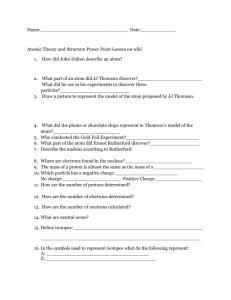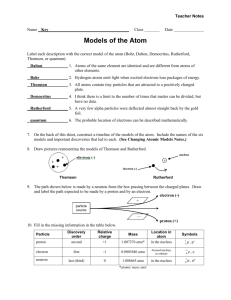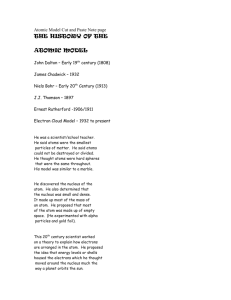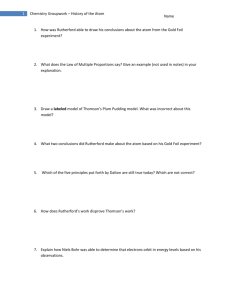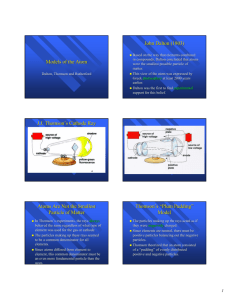Democritus 460 BC
advertisement
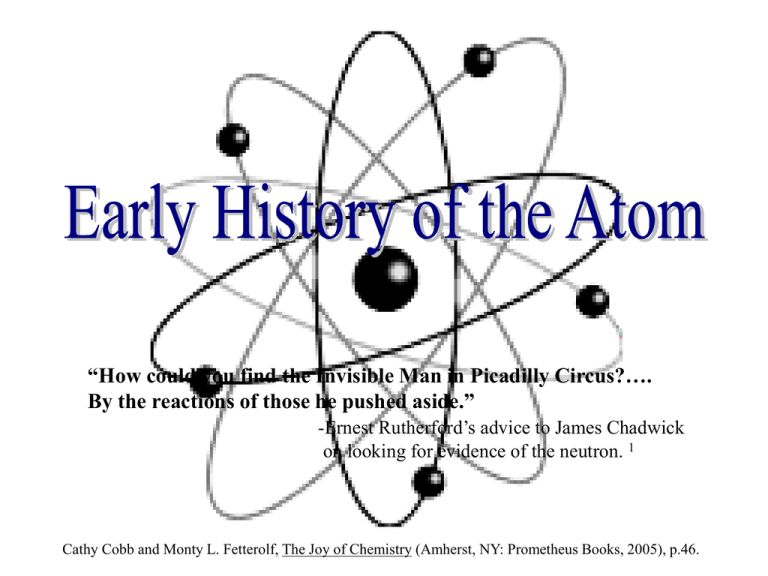
“How could you find the Invisible Man in Picadilly Circus?…. By the reactions of those he pushed aside.” -Ernest Rutherford’s advice to James Chadwick on looking for evidence of the neutron. 1 Cathy Cobb and Monty L. Fetterolf, The Joy of Chemistry (Amherst, NY: Prometheus Books, 2005), p.46. Democritus 460 BC - 370 BC • went against, Aristotle, who believed that matter was composed of four qualities: earth, fire, air and water • all matter is composed of small, indivisible particles • coined the term ‘atomos’ John Dalton 1766-1844 • developed a model on the atom based on already established laws: • the law of conservation of mass (Lavoisier) • the law of definite proportions (Proust) • the law of multiple proportions (Dalton) Law of Definite Proportions Mass of Mass of Mass of Water Hydrogen Oxygen 18 g 2g 16 g 9g 36 g 1g 8g Mass Ratio Summary of Laws Used by Dalton Law of Conservation of Mass Mass is neither created nor destroyed in a chemical reaction. Example: 2 g of hydrogen reacts with 16 g oxygen to produce 18 g water. Law of Definite Proportions Elements combine in definite, fixed ratios by mass to form compounds. Example: water is always 1 gram of hydrogen for 8 grams of oxygen. Law of Multiple Proportions When 2 or more elements combine to form different compounds, the ratio of the second element to a fixed mass of the first is always a small, whole number ratio. Example: Water versus hydrogen peroxide: if 1 g of hydrogen in each, then 8 g of oxygen in water to 16 g of oxygen in hydrogen peroxide. This gives 1 to 2 ratio by mass of oxygen in the two compounds. Dalton’s Atomic Theory 1803 1) All matter is made up of extremely small particles called atoms. 2) Atoms of a given element are identical in size, mass and other properties; atoms of different elements differ in size, mass and other properties. 3) Atoms cannot be subdivided, created or destroyed. 4) Atoms of different elements can combine in fixed, small, whole number ratios to form compounds. 5) Chemical reactions involve the combining, separating or rearrangement of atoms to form new substances. Dalton’s model of the atom: Sir William Crookes Cathode Ray Tubes (1870’s) http://members.chello.nl/~h.dijkstra19/page7.html Crooke’s Maltese Cross Tube Sir J. J. Thomson 1856 - 1940 • What were these particles??? • Thomson’ hypothesis: since the beam came from the cathode (a negative electrode), and given how the ray is deflected by a magnet, the particles have a negative charge. J. J. Thomson’ experiments with the CRT 1890’S Tried to separate the charge from the particles by bending the rays with a magnet and then deflecting with electric plates. He could not separate the two. Fig. 2.3b, p.62 Reverse the electrodes on the cathode ray tube: deflection by positive plate!! Discovery of a positive component. Thomson used the hydrogen ion, which is just a single proton, so he missed that atoms have positively charges particles - he thought the whole atom was a ball of positive charge. Fig. 2.5, p.63 J. J. Thomson’ experiments with the CRT 1890’S • Calculated the charge to mass ratio of these particles by measuring the degree of deflection with different strength magnetic and electric fields. • No matter which gas he used in the tube, the calculated charge to mass ratio of the particles was the same (1/1800 of a hydrogen atom). • Thomson’s experiments provided convincing evidence that the rays consisted of charged particles and he is credited with the discovery of the electron (Nobel Prize 1906) Thomson’s Plum Pudding Model (1897) • Thomson concluded that the cathode ray was made up of negatively charged subatomic particles, later called electrons (e-) • No matter what metal the electrodes were made of, or what gas filled the tube, the same charge to mass ratio was calculated. All atoms have them, and they are identical in all atoms • Thomson reasoned that atoms also must have a positive component - he reasoned a ball of positive charge with the negative charges spread throughout, like raisins in plum pudding. ball of positive charge electrons Millikan’s Oil Drop Experiment 1909 • Determined the charge of an electron. Given Thomson’s charge to mass ratio calculation, the mass of an electron could then also be determined. • Oil drops were given a negative charge by attaching electrons to them. By balancing the force of gravity with the force from an electric field on these droplets, Millikan could determine the magnitude of the charge on each oil drop, and found that the charge was always some multiple of 1.6 x 10-19 C. • Therefore, the charge of a single electron was 1.6 x 10-19 C. Millikan’s Oil Drop Experiment 1909 Fig. 2.4a, p.63 Radioactivity • One of the pieces of evidence for the fact that atoms are made of smaller particles came from the work of Marie Curie (1876-1934). • She discovered radioactivity, the spontaneous disintegration of some elements into smaller pieces. Types of Radioactive Emissions Types of Radioactive Emissions Ernest Rutherford New Zealand (1871-1937) Responsible for the modern, nuclear view of the atom Rutherford laboratory Gold Foil Experiment (1909) Rutherford was trying to prove the Plum Pudding model. If supported, the alpha particles would all pass straight through the foil. 02M11AN1.MOV Rutherford’s Observations • Most of the alpha particles passed straight through, as expected. • Some were slightly deflected. • Some were completely deflected!! These deflections were unexpected…. Rutherford’s Thoughts “….as if you had fired a 15-inch [artillery] shell at a piece of tissue paper and it came back and hit you.” Rutherford’s Conclusions and Model • Majority of the atom was empty space • The positive charge and 99% of the atom’s mass concentrated in a small volume in the center. Discovery of the nucleus!! (dense and positive) • Electrons orbited around the nucleus. Much smaller mass than the nucleus. Rutherford’s Model 1911 Two problems: 1. The mass of atom did not equal the mass of the positive charge alone. 2. Why didn’t the electrons fall into the nucleus? What keeps them in motion? Rutherford’s First Problem • Rutherford’s model suggested atoms composed of two subatomic particles with equal but opposite charges: electrons and protons (*see last slide). • Problem - mass of atom not equal to mass of protons alone - must be another subatomic particle to make up the difference. • 1932 - Chadwick discovers the neutron - a subatomic particle present in all atoms that has about the same mass as a proton but no electrical charge!! Rutherford’s Second Problem Why didn’t the electrons fall into the nucleus? What keeps them in motion? …..answered by Bohr…..next chapter…...stay tuned ABOUT PROTONS…… In the early 1920's Rutherford and other physicists made a number experiments, transmuting one atom into another. In every case, hydrogen nuclei were emitted in the process. It was apparent that the hydrogen nucleus played a fundamental role in atomic structure, and by comparing nuclear masses to charges, it was realized that the positive charge of any nucleus could be accounted for by an integer number of hydrogen nuclei. By the late 1920's physicists were regularly referring to hydrogen nuclei as 'protons'. The term proton itself seems to have been coined by Rutherford, and first appears in print in 1920. http://www.physlink.com/Education/askExperts/ae46.cfm
